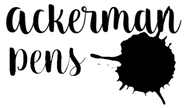Shaping Our Quill Nibs
Once you receive your Quill nibs, you will want to shape them for your purpose. When you order Quill nibs, either in a pen or as Quill nib sticks, they are shipped with a chisel tip. This is the way we make them, and a chisel tip is a popular shape to use when working with thick lines, such as broad point lettering.
Note: This is one page of two pages describing how you use our Quill nibs. The page Using quill nibs introduces our Quill nibs and how to fit them into your pen.
Quill nibs are made from cellulose acetate in the form of a clear film. Once we fashion the film into our Quill nibs, you can trim and shape the leading edge of your quill nib to suit your purpose. We recommend using small sewing scissors like those shown below.


We prefer the scissors with the curved tip, which lets you cut more intricate shapes, but both of these scissors will work.
Examples of quill nib shapes
| We ship our quill nibs with a chisel tip. | |
|
Some people enjoy drawing or lettering with a chisel tip for Gothic lettering or broad point drawing. You can also trim the leading edge of your nib on an angle. This lets you draw circles and curves gracefully. |
|
| The most popular shape is the pointed tip, where the angle of the point can vary from shallow to steep. | |
| Pointed quill nibs don't act like flexible pointed metal nibs, although they can approximate the feel and behavior. You can vary your line width by increasing or reducing your hand pressure and thereby increasing or decreasing the amount of nib that comes in contact with the paper. |
Trimming quill nibs
When we talking about trimming or shaping Quill nibs, we refer to two features on the nib - the "spine" and the "wings". The spine runs down the center of the nib while there are two wings, one on the left, the other on the right.
Trimming chisel tips
This tip is more popular with calligraphers, but drawers can use it to good effect. You can trim the nib at various points to reduce the width of the chisel tip end. When drawing, you can use the chisel tip to fill in large areas quickly, such as drawing black backdrops.
- Clip one wing at 45 degrees. Begin halfway up the wing. Make sure you don’t start the cut near the center line.
- Clip the other wing at 45 degrees beginning halfway up the wing.
- Clip the spine if you want to. If you leave the spine untouched, it will provide firmer pressure on the nib as it glides over the paper.
- Pointed tips are popular with drawers, sketchers and anyone who wants to draw thinner lines and lines with a variable width. You can twist and turn the tip of the nib as you draw leaving wider or thinner lines behind.
- Something in between lets you create shapes that combine features of broad point and pointed tip.
Trimming pointed nibs
This shape is popular with drawers, sketchers and anyone who want to draws thinner lines and lines with variable width.
These are just suggestions for shapes you can try. The results will be combination of how you shape the nib and how you move the shaped nib on paper. You should experiment with different cuts and test their effects.
- Clip one wing at 45 degrees. Try to start your cut as close to the center line as possible. The closer you get, the more pointed the tip.
- Clip the other wing in the same manner.
- Clip the spine at 45 degrees. Try to start your cut just above the base where the spine connects with the wings.
Combine these techniques to trim your quill nibs somewhere between the two styles.
